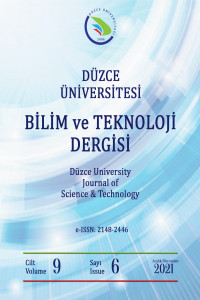Abstract
Gelişen teknoloji ile bilginin yayılması ve korunması gereksinimi giderek önem kazanmaktadır. Son dönemde bilişim sistemlerine yönelik saldırılar önemli düzeyde artış göstermiştir. Saldırı sayısındaki artışın yanı sıra farklı türlerde meydana gelen saldırılar sistemler üzerinde büyük bir tehdit oluşturmaktadır. Yapılan bu saldırılar neticesinde kurumlar ve kullanıcılar ciddi zararlar görmektedir. Bu noktada Saldırı Tespit Sistemleri (IDS) oldukça önemli bir konuma sahiptir. Sistemlere yönelik yapılan bu saldırıların önceden tespit edilip gerekli raporların hazırlanması ileride karşılaşılabilecek tehditlerin etkisini azaltabilmektedir. Son zamanlarda yapılan çalışmalar Saldırı Tespit Sistemlerinin performanslarını artırma doğrultusunda gerçekleşmektedir. Bu çalışmada NSL-KDD veri seti ile SVM, KNN, Bayesnet, NavieBayes, J48 ve Random Forest algoritmaları kullanılarak sınıflandırma yapılmış, özellik çıkarımı gerçekleştirilerek sonuçların iyileştirilmesi amaçlanmıştır. Çalışma sonucunda KNN algoritması % 98.1237 doğruluk oranı ile en iyi performansa sahip olduğu gözlemlenmiştir. Bunun yanı sıra artan fold ve komşuluk sayısının sınıflandırma sonucuna etkisi karşılaştırmalı olarak incelenmiştir.
Keywords
References
- [1] K. Mandal, M. Rajkumar, P. Ezhumalai, D. Jayakumar, and R. Yuvarani, “Improved security using machine learning for IoT intrusion detection system”, Materials Today: Proceedings, doi: https://doi.org/10.1016/j.matpr.2020.10.187.
- [2] J. Yu, X. Ye, and H. Li, “A high precision intrusion detection system for network security communication based on multi-scale convolutional neural network”, Future Generation Computer Systems, doi: https://doi.org/10.1016/j.future.2021.10.018.
- [3] A.S. Dina and D. Manivannan, "Intrusion detection based on machine learning techniques in computer networks", Internet of Things, vol. 16, no. 100462, 2021.
- [4] S. Roy, J. Li, B.J. Choi, and Y. Bai, "A lightweight supervised intrusion detection mechanism for IoT networks," Future Generation Computer Systems, vol. 127, pp. 276-285, 2022.
- [5] N. V. Sharma and N. S. Yadav. "An optimal intrusion detection system using recursive feature elimination and ensemble of classifiers," Microprocessors and Microsystems, vol. 85, 2021.
- [6] P. Nimbalkar and D. Kshirsagar, "Feature selection for intrusion detection system in Internet of-Things (IoT)," ICT Express, vol. 7, pp. 177-181, 2021.
- [7] W. Fang, X. Tan, and D. Wilbur, "Application of intrusion detection technology in network safety based on machine learning," Safety Science, vol. 124, 2020.
- [8] A. Verma and V. Ranga, “Statistical analysis of CIDDS-001 dataset for Network Intrusion Detection Systems using Distance-based Machine Learning”, Procedia Computer Science, vol. 125, pp. 709-716, 2018.
- [9] J. Gu and S. Lu, ''An effective intrusion detection approach using SVM with naïve Bayes feature embedding,'' Computers & Security, vol. 103, 2021.
- [10] M. Tavallaee, E. Bagheri, W. Lu, and A. Ghorbani, “A Detailed Analysis of the KDD CUP 99 Data Set,” Second IEEE Symposium on Computational Intelligence for Security and Defense Applications (CISDA), 2009.
Abstract
With the developing technology, the need for the dissemination and protection of information is becoming increasingly important. Recently, attacks on information systems have increased significantly. In addition to the rise in the number of attacks, attacks of different types pose a great threat to systems. As a result of these attacks, institutions and users suffer serious damages. At this point, Intrusion Detection Systems (IDS) have a very important position. The pre-detection of these attacks on the systems and the preparation of the necessary reports can reduce the impact of the threats that may be encountered in the future. Recent studies are carried out so as to increase the performance of IDS. In this paper, classification was made using NSL-KDD dataset and SVM, KNN, Bayesnet, NavieBayes, J48 and Random Forest algorithms, and it was aimed to compare performance of these classifications by using WEKA. Consequently, it has been reached that the KNN algorithm had the best performance with an accuracy rate of 98.1237 %. In addition, the effect of increasing the number of folds and neighborhoods on the classification result has been examined comparatively.
Keywords
References
- [1] K. Mandal, M. Rajkumar, P. Ezhumalai, D. Jayakumar, and R. Yuvarani, “Improved security using machine learning for IoT intrusion detection system”, Materials Today: Proceedings, doi: https://doi.org/10.1016/j.matpr.2020.10.187.
- [2] J. Yu, X. Ye, and H. Li, “A high precision intrusion detection system for network security communication based on multi-scale convolutional neural network”, Future Generation Computer Systems, doi: https://doi.org/10.1016/j.future.2021.10.018.
- [3] A.S. Dina and D. Manivannan, "Intrusion detection based on machine learning techniques in computer networks", Internet of Things, vol. 16, no. 100462, 2021.
- [4] S. Roy, J. Li, B.J. Choi, and Y. Bai, "A lightweight supervised intrusion detection mechanism for IoT networks," Future Generation Computer Systems, vol. 127, pp. 276-285, 2022.
- [5] N. V. Sharma and N. S. Yadav. "An optimal intrusion detection system using recursive feature elimination and ensemble of classifiers," Microprocessors and Microsystems, vol. 85, 2021.
- [6] P. Nimbalkar and D. Kshirsagar, "Feature selection for intrusion detection system in Internet of-Things (IoT)," ICT Express, vol. 7, pp. 177-181, 2021.
- [7] W. Fang, X. Tan, and D. Wilbur, "Application of intrusion detection technology in network safety based on machine learning," Safety Science, vol. 124, 2020.
- [8] A. Verma and V. Ranga, “Statistical analysis of CIDDS-001 dataset for Network Intrusion Detection Systems using Distance-based Machine Learning”, Procedia Computer Science, vol. 125, pp. 709-716, 2018.
- [9] J. Gu and S. Lu, ''An effective intrusion detection approach using SVM with naïve Bayes feature embedding,'' Computers & Security, vol. 103, 2021.
- [10] M. Tavallaee, E. Bagheri, W. Lu, and A. Ghorbani, “A Detailed Analysis of the KDD CUP 99 Data Set,” Second IEEE Symposium on Computational Intelligence for Security and Defense Applications (CISDA), 2009.
Details
| Primary Language | English |
|---|---|
| Subjects | Engineering |
| Journal Section | Research Article |
| Authors | |
| Publication Date | December 31, 2021 |
| Published in Issue | Year 2021 Volume: 9 Issue: 6 - ICAIAME 2021 |

